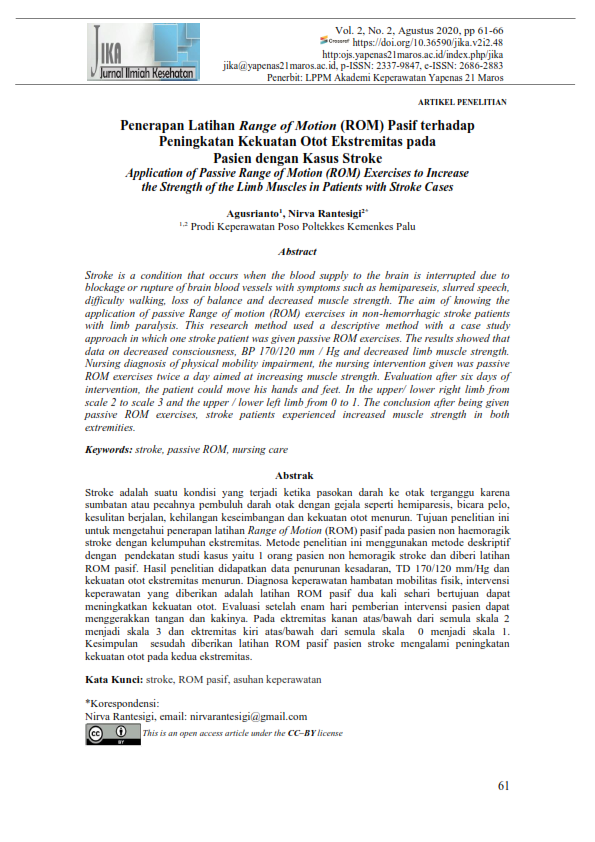Application of Passive Range of Motion (ROM) Exercises to Increase the Strength of the Limb Muscles in Patients with Stroke Cases
DOI:
https://doi.org/10.36590/jika.v2i2.48Keywords:
stroke, passive ROM, nursing careAbstract
Stroke is a condition that occurs when the blood supply to the brain is interrupted due to blockage or rupture of brain blood vessels with symptoms such as hemipareseis, slurred speech, difficulty walking, loss of balance and decreased muscle strength. The aim of knowing the application of passive Range of motion (ROM) exercises in non-hemorrhagic stroke patients with limb paralysis. This research method used a descriptive method with a case study approach in which one stroke patient was given passive ROM exercises. The results showed that data on decreased consciousness, BP 170/120 mm / Hg and decreased limb muscle strength. Nursing diagnosis of physical mobility impairment, the nursing intervention given was passive ROM exercises twice a day aimed at increasing muscle strength. Evaluation after six days of intervention, the patient could move his hands and feet. In the upper/ lower right limb from scale 2 to scale 3 and the upper / lower left limb from 0 to 1. The conclusion after being given passive ROM exercises, stroke patients experienced increased muscle strength in both extremities.
Downloads
References
Aziz Alimul A. 2012. Pengantar kebutuhan dasar manusia: aplikasi konsep dasar proses keperawatan. Jakarta: Salemba Medika.
Derison Marsinova Bakara, Surani Warsito. 2016. Latihan Range Of Motion (ROM) terhadap rentang sendi pasien pasca stoke. Idea Nursing Journal, 7(2): 12-18.
Junaidi I. 2011. Stroke waspadai ancamannya. Yogyakarta: ANDI.
Maimurahman H, Fitria Cemi M. 2012. Keefektifan Range Of Motion (ROM) terhadap kekuatan otot ekstremitas pada pasien stroke. Profesi Media Publikasi Penelitian. 9: 1-7.
Marlina. 2017. Pengaruh Latihan ROM terhadap peningkatan kekuatan otot pada pasien stroke iskemik. Idea Nursing Journal. 3(1): 11-20.
Murtaqib M. 2013. Perbedaan Latihan Range Of Motion (ROM) pasif dan aktif selama 1-2 minggu terhadap peningkatan rentang gerak sendi pada gerak sendi pada penderita stroke di Kecamatan Tanggul Kabupaten Jember. Jurnal Keperawatan Sudirman (The Journal of Nursing). 8(1): 58-68.
Muttaqin Arif. 2012. Pengantar asuhan keperawatan klien dengan gangguan sistem persyarafan. Jakarta: Salemba Medika.
Rahayu KIN. 2015. Pemberian Latihan Range of Motion (ROM) terhadap kemampuan motorik pada pasien post stroke di rsud gambiran : the influence of range of motion exercise to motor capabily of post-stroke patien at the Gambiran Hospital. Jurnal Keperawatan. 6(2): 102-107.
Risnanto, Uswatun, Insani. 2014. Buku Ajar asuhan keperawatan medikal bedah, sistim muskuloskeletal. Budi Utama: Yogyakarta
Wilkinson Judith M. 2007. Buku saku, diagnosa keperawatan dengan intervensi NIC dan kriteria hasil NOC. Edisi 7. Jakarta: EGC.









